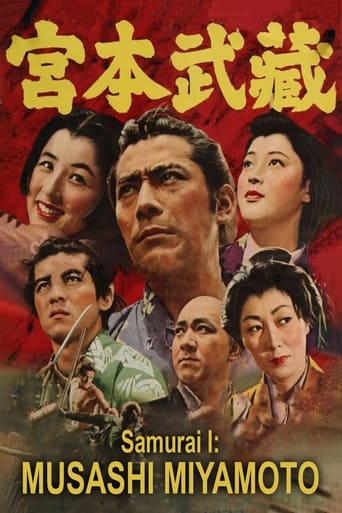foxfirebrand
The importance of the Miyamo Musashi saga has been lost somewhat today, even in Japan. These were not just early high-quality color samurai movies, not just great films-- they were a nationwide event, and a milestone in Japanese social evolution. The early 50s were a time of postwar healing, and there were unsettled questions about the national character. The Miyamo Musashi saga used the past to dramatize issues of morality-- and, even more important at the time, morale. Japan had no problem westernizing and living under the rule of law under terms imposed by victors in war-- the knotty issue was, how much of the past do we keep alive in our daily thoughts and actions, and just how much of the real Japan, the one we remember, will our children and grandchildren inherit, once the aftermath of global war has subsided? Watch these films with such then-important issues in mind, and your experience will be deepened and enriched. All three episodes are directed by Hiroshi Inagaki and star Toshiro Mifune as Miyamoto-san, in a performance that is perfection. Miyamoto Musashi shows the young samurai aspirant as a hot-headed, imperfect man, neither hero nor monster-- but possessed of a fierce dark force that could impel him toward either outcome. The question of women looms large in this trilogy-- how to treat them, what kind of woman to honor and what kind to avoid, and just how the diametrically-opposite traits of women work in the world, whether at odds or in harmony with those of men. All these issues are played out without preachiness, in the actions of real people, well-drawn characters whom we meet and get to know before the episode ends in a series of parting of ways. (continued on the page for Ichijoji no Ketto)
James Osborne
Toshiro Mifune (of Akira Kurosawa fame) stars as Takezo. A young man who seeks fame as a warrior. He and his friend Matahachi join to fight in a civil war. When their "platoon" (for lack of a better term due to my lack of Japanese warfare knowledge) is wiped out, the two young men confide in the help of two women.The two women rob the dead bodies of Samurai. When a group of bandits wants to cash in on their treasure, Takezo fights off and kills the bandits. When Oko (the mother of the two women) observes this, she falls for Takezo. When he refuses and runs off, she tells Akemi and Matahachi that Takezo forced himself, and she refused. So, Akemi, Oko, and Matahachi leave. Only for Takezo to return to an empty home. Takezo tries to return to his home village to let Matahachi's fiancé and mother know that he is still alive. When he is accused of leaving Matahachi for dead he is pursued by the town in a manhunt. Otsu, Matahachi's fiancé, learns of Matahachi's marriage to Oko. She eventually falls for Takezo. During all this, Takezo is capturd by a Buddhist monk. Only part of the monk's larger scale plan of eventually moralizing and training Takezo. Thus, Takezo becomes the film title, Miyamoto Musashi.An excellent and colorful film. Toshiro Mifune excels as Takezo. He proves that he is up to play any type of character. His character is somewhat similar to that of his character in Seven Samurai. Ambitious, but not as strong and mature as he should be for a samurai.If you don't know too much about classic samurai cinema, this is a good place to start (this is part one in a trilogy of three films). With his short running time and color film, it may help you break into the other samurai classics that are in B&W (Kurosawa's Seven Samurai, Yojimbo/Sanjuro, etc.,).As a note, this won of the Academy Award for Best Foreign Language Film in 1955.
mtwmtw
The first of a trilogy that really should be viewed as a whole. This elegant film tells of the very humble beginnings of Miyamoto Mushashi, who has become a paragon of Bushido and Giri. A Samurai's Samurai.However, you have no inkling of this at the beginning of the movie. What we see is dirt and squalor and a desperate chance to get out from beneath the mud. It all goes wrong and things look desperate.As the movie progresses in the slow, methodical, often obtuse, Japanese fashion we become engrossed in the plot and the lives of our protagonists. Toshiro Mifune shows a vast range of emotion, power and character growth in these this movie. To get the full flavour of the story you must also watch the next two movies in this trilogy (2) "Duel at Ichijoji Temple"(1955) (USA)and (3) "Duel on Ganryu Island" (1956)(USA.
dorlago
This is the best of the Samurai Trilogy! A very entertaining, fast paced film! Mifune does his "Wild Man" thing wonderfully! The photography is breathtaking. It's nice to see Mifune in color for a change! Loosely taken from the pages of Japanese history this is the story of a mans triumph over the ravages of war, social stigma and his own atavistic tendencies. The moral of this film.....Maybe love does not conquer all but it sure helps!




